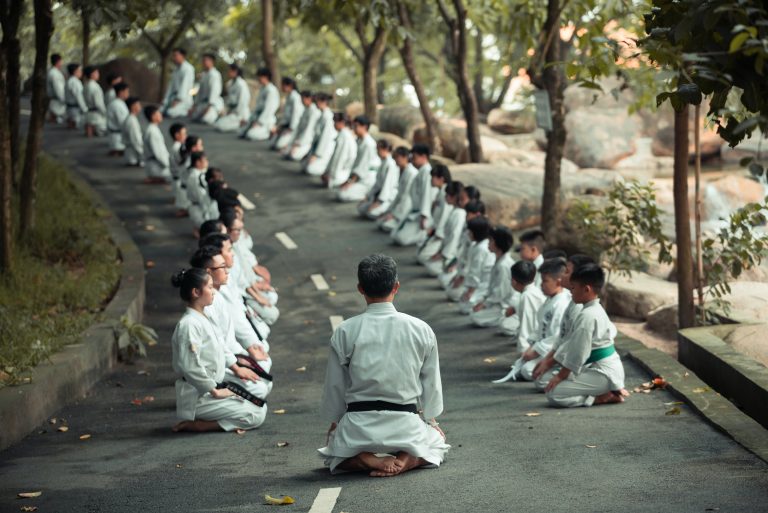What is the Difference between Karate and Taekwondo?
The martial arts are often thought of as a single thing, much like any activity with unified rules. But several different types of martial arts exist, Karate and Taekwondo being two of the most popular. With their similarities, it’s easy to see why these two styles are often confused with each other. Despite their similarities, though, Karate and Taekwondo are distinct disciplines with important differences. This article will go into what exactly sets Karate and Taekwondo apart.
History of Karate and Taekwondo
Karate and Taekwondo are two widely practiced martial arts originating in East Asia. Karate is said to have developed in the Ryukyu Islands of what is now Okinawa, Japan, around the 1400s. It was developed as a hybrid of various Chinese and Okinawan fighting styles, and refined over the next several hundred years. It was popularized back in the United States in the 1950s and 1960s, and has become an internationally recognized form of martial arts.
Meanwhile, Taekwondo originated in Korea around the same time as Karate. It was developed from traditional Korean defenses and Chinese martial arts, such as Kung Fu. After being unified under a single name in 1955, Taekwondo was first promoted as an Olympic sport during the 1988 Seoul Olympics. Since then, it’s become one of the world’s popular martial arts and is regarded as Korea’s national sport.
Karate Techniques
Karate is based on strong stances and hand-to-hand combat. Stances range from patient waiting stances to more forward and active stances. At higher levels of practice, karate practitioners can use stances to quickly transition and apply powerful strikes.
Karate practitioners use punches, kicks, grapples, and throws to take down their opponents as they move around in a self-defense situation. In addition, practitioners of karate use blocks and parries to defend themselves against incoming attacks. A karate stance may shift to be more defensive or offensive depending on what’s called for—for example, a defensive stance will be taken when an opponent is ready to strike, while an offensive stance might be taken to score a surprise strike or gain an advantageous position.
Taekwondo Techniques
Taekwondo is centered around fast, aggressive strikes, but also has elements of defense similar to Karate. Techniques like footwork and strikes are used to varying degrees depending on rank. Footwork is important in Taekwondo because of its emphasis on fast from long distances. In addition, practitioners frequently utilize grappling and joint locks that control an opponent’s movement in order to setup strikes or throws.
Taekwondo strikes often come from angled positions which are difficult to block. These strikes are usually delivered with the palms or elbows instead of fists or hands. Blocking is also an important part of taekwondo – practitioners aim to override their opponents’ kicks with their own kicks or blocks.
Gear Required for Karate and Taekwondo
The type of gear used in Karate and Taekwondo vary quite a bit—though they do share many similarities too. Both forms require lightweight and breathable uniforms (called “gi”), belts with color gradients that signify rank progression, and general protective gear (such as shin guards, instep guards, groin guards and sparring gloves).
In addition to these standard items, practitioners of each form require additional specialized training gear—especially if they are training for sparring or competition. For Karate, practitioners must also wear padded gloves, headgear, and gum shield protection when sparring. For Taekwondo practitioners, a variety of protective targets (such as kicking pads, body pads or body shields) are used for full contact sparring sessions or forms competitions.
Scoring Differences between Karate and Taekwondo
The martial arts competitions differ between Karate and Taekwondo too. While both follow the same general ruleset, they have different ways they score points in competition.
In Karate competitions, points are scored depending on the part of the body hit and the technique used in delivering the strike—shorter strikes tend to score higher than longer strikes. Strikes that are made with great power usually signify a higher value too – it’s not just about the number of strikes landed too—control of technique is also important. The points awarded also depend on whether the attacker remains in control while delivering the strike throughout its whole trajectory.
In Taekwondo competitions points are scored differently than in Karate. Strikes may be scored depending on the technique used is instead of the power used for Karate competitions, as power is not a measure for scoring in this style. The judges look for accuracy in limit when scoring; a well controlled delivery will score higher than one lacking control over their technique.
Using Both Styles Together
Because of their similarities and differences between Karate and Taekwondo it is possible to combine both styles into a hybrid form of martial arts. By leveraging the strengths found in each style, practitioners can develop powerful self-defense skills from the two styles together. This type of hybridization has become popular among martial arts enthusiasts who seek out versatile tools for self-defense and competition preparation.
Conclusion
The martial arts are complex and diverse activities that often draw distinctions between different forms based on history, techniques used, gear needed, and scoring systems. As an example comparison, this article delved into what makes Karate and Taekwondo different from each other: from their origins to their respective techniques and scoring systems. Having an understanding of how these two martial arts differ will help you make an informed decision when pursuing self-defense studies or competitive endeavors. Additionally, learning both disciplines can lead to the development of powerful hybrid self-defense skills – if you’re keen to try something different!
What is the Difference between Karate and Taekwondo?
Karate and Taekwondo are two of the most popular martial arts in the world. Both are highly respected for their discipline, techniques, and physical aspects. However, many people often confuse these disciplines with one another. They look similar, and even some of the techniques overlap. In this article, we will explore the key differences between karate and taekwondo to help people better understand these two martial arts.
Origins and History of Karate and Taekwondo
Karate and Taekwondo are both martial arts that originate from Asia, specifically Japan and Korea. Karate originated in the Ryukyu Kingdom, now present-day Okinawa, Japan. It was initially a self-defense technique used by the peasants to protect themselves from bandits. It later evolved into an art form and was introduced to Japan in the early 20th century. Taekwondo, on the other hand, originated in Korea in the 1940s as a combination of traditional Korean martial arts, Japanese martial arts, and Chinese martial arts.
Philosophy and Purpose
Karate and Taekwondo are more than just martial arts. Both disciplines have a philosophy behind them that emphasizes the development of the individual as a whole. Karate emphasizes the cultivation of the inner self, self-discipline, and respect for others. Taekwondo, on the other hand, emphasizes the balance between the internal and external self, the unification of body and mind, and the development of strength and agility.
Forms and Techniques
One of the most significant differences between Karate and Taekwondo is the forms and techniques they employ. Karate techniques mainly consist of hand strikes, elbow strikes, kicks, and knee strikes. Taekwondo techniques, on the other hand, focus on high, fast, and powerful kicks, often executed in rapid succession. Taekwondo also utilizes more spinning, jumping, and flying kicks than Karate.
Uniform, Belt System, and Ranking
Karate and Taekwondo use different types of uniforms (gi or dobok). Karate uniforms are usually made of canvas and are thicker than Taekwondo uniforms. Taekwondo uniforms are lighter, made of thinner fabric, and usually have a V-neck collar. The belt systems for both disciplines have different colors, with Karate having fewer belt colors than Taekwondo. In both Karate and Taekwondo, students earn belts to signify their level of proficiency, with the highest being the black belt.
Competition
Both Karate and Taekwondo offer competition opportunities, although the rules and styles of competition differ. Karate competitions usually focus on kata (a sequence of techniques performed against an imaginary opponent) and kumite (sparring). Taekwondo competitions commonly include sparring, poomsae (similar to kata), and breaking (the technique of breaking boards with various strikes and kicks).
Conclusion
In conclusion, Karate and Taekwondo are both well-respected martial arts, and while they may appear similar, they have distinct differences. The philosophical and practical differences between these martial arts come down to the techniques, the style of execution, and the history behind them. Both Karate and Taekwondo have something unique to offer, and choosing between them comes down to individual preference and goals.
Inhaltsverzeichnis






